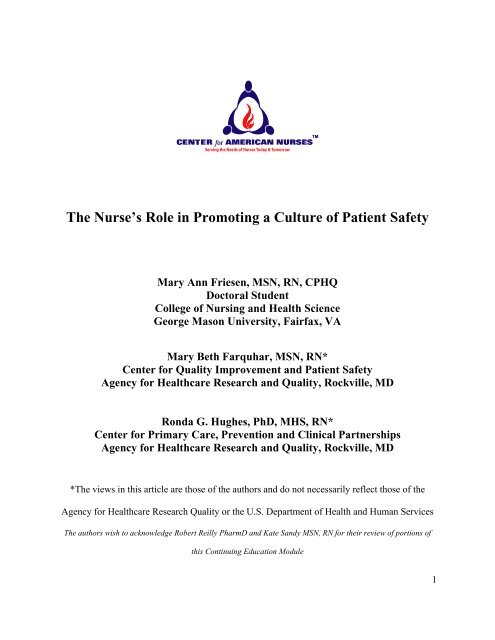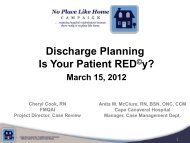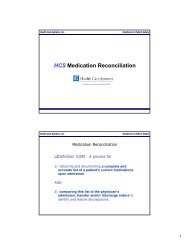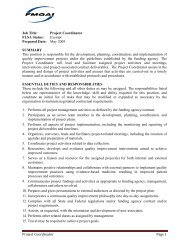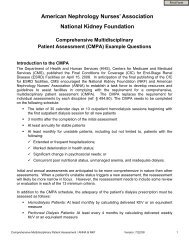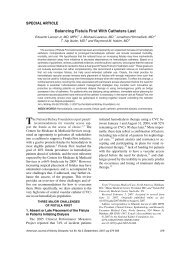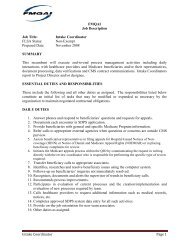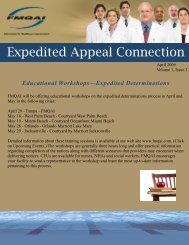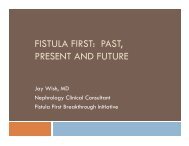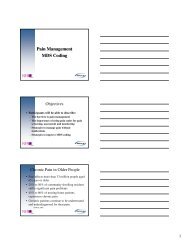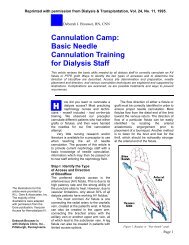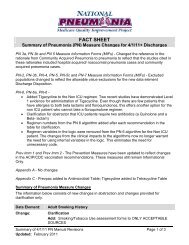The Nurse's Role in Promoting a Culture of Patient Safety - FMQAI
The Nurse's Role in Promoting a Culture of Patient Safety - FMQAI
The Nurse's Role in Promoting a Culture of Patient Safety - FMQAI
Create successful ePaper yourself
Turn your PDF publications into a flip-book with our unique Google optimized e-Paper software.
<strong>The</strong> Nurse’s <strong>Role</strong> <strong>in</strong> Promot<strong>in</strong>g a <strong>Culture</strong> <strong>of</strong> <strong>Patient</strong> <strong>Safety</strong><br />
Mary Ann Friesen, MSN, RN, CPHQ<br />
Doctoral Student<br />
College <strong>of</strong> Nurs<strong>in</strong>g and Health Science<br />
George Mason University, Fairfax, VA<br />
Mary Beth Farquhar, MSN, RN*<br />
Center for Quality Improvement and <strong>Patient</strong> <strong>Safety</strong><br />
Agency for Healthcare Research and Quality, Rockville, MD<br />
Ronda G. Hughes, PhD, MHS, RN*<br />
Center for Primary Care, Prevention and Cl<strong>in</strong>ical Partnerships<br />
Agency for Healthcare Research and Quality, Rockville, MD<br />
*<strong>The</strong> views <strong>in</strong> this article are those <strong>of</strong> the authors and do not necessarily reflect those <strong>of</strong> the<br />
Agency for Healthcare Research Quality or the U.S. Department <strong>of</strong> Health and Human Services<br />
<strong>The</strong> authors wish to acknowledge Robert Reilly PharmD and Kate Sandy MSN, RN for their review <strong>of</strong> portions <strong>of</strong><br />
this Cont<strong>in</strong>u<strong>in</strong>g Education Module<br />
1
Abstract<br />
<strong>The</strong>re are vary<strong>in</strong>g consequences <strong>of</strong> medical errors. Ironically, these errors <strong>in</strong>volve those<br />
<strong>in</strong>tend<strong>in</strong>g to help, not harm patients. Though errors are <strong>of</strong>ten blamed on <strong>in</strong>dividuals, the true<br />
roots <strong>of</strong> these errors are found <strong>in</strong> the comb<strong>in</strong>ation <strong>of</strong> the workplace environment <strong>in</strong> which<br />
healthcare is delivered and <strong>in</strong> the <strong>in</strong>teraction among healthcare providers. To understand the<br />
causes <strong>of</strong> error, it is important to consider the dynamics <strong>of</strong> healthcare as a system, <strong>in</strong>fluenced by<br />
<strong>in</strong>dividuals and culture. For medical errors to decrease and for patient safety to improve, our<br />
healthcare system needs to change.<br />
Nurses are <strong>in</strong> a unique position to improve patient safety because <strong>of</strong> their <strong>in</strong>herent<br />
proximity to patients. This position gives nurses the needed <strong>in</strong>sight to identify problems <strong>in</strong><br />
healthcare systems and to be part <strong>of</strong> patient safety solutions. However, to do this, nurses must be<br />
supported and encouraged without fear <strong>of</strong> retribution, as well as have an understand<strong>in</strong>g <strong>of</strong> how<br />
organizational culture change can be accomplished. As such, the purpose <strong>of</strong> this paper is to<br />
present an overview <strong>of</strong> patient safety problems associated with organizational culture and how<br />
nurses can be part <strong>of</strong> organizational change promot<strong>in</strong>g patient safety. After completion <strong>of</strong> this<br />
module, nurses will be able to:<br />
1. Describe the risks medical errors pose to patient safety<br />
2. Discuss the culture <strong>of</strong> safety<br />
3. Compare and contrast the culture <strong>of</strong> safety with the culture <strong>of</strong> blame<br />
4. Describe strategies to promote a culture <strong>of</strong> safety <strong>in</strong> the healthcare environment<br />
2
<strong>The</strong> Problem <strong>of</strong> Medical Errors<br />
More than 140 years ago, Florence Night<strong>in</strong>gale warned, “the very first requirement <strong>in</strong> a<br />
Hospital is that it should do the sick no harm” (Night<strong>in</strong>gale, 1863, preface). This concern was<br />
echoed <strong>in</strong> Cross<strong>in</strong>g the Quality Chasm: A New Health System for the 21 st Century, where the<br />
Institute <strong>of</strong> Medic<strong>in</strong>e (IOM) called for safety <strong>in</strong> the delivery <strong>of</strong> healthcare <strong>in</strong>dicat<strong>in</strong>g that<br />
“patients should be safe from <strong>in</strong>jury caused by the care system” (Institute <strong>of</strong> Medic<strong>in</strong>e, 2001, p.<br />
8). Today, the <strong>in</strong>creas<strong>in</strong>g complexity <strong>of</strong> healthcare has contributed to the grow<strong>in</strong>g problem <strong>of</strong><br />
medical errors (Wachter, 2004). Accord<strong>in</strong>g to the Committee on Quality <strong>of</strong> Healthcare <strong>in</strong><br />
America, the majority <strong>of</strong> quality problems and medical errors occur “because <strong>of</strong> fundamental<br />
shortcom<strong>in</strong>gs <strong>in</strong> the ways care is organized” (Institute <strong>of</strong> Medic<strong>in</strong>e, 2001, p. 25), not <strong>in</strong>dividual<br />
error or negligence (Kohn, Corrigan, & Donaldson, 2000).<br />
<strong>The</strong> pervasiveness <strong>of</strong> medical errors garnered widespread attention after the IOM<br />
published its sem<strong>in</strong>al report, To Err is Human: Build<strong>in</strong>g a Safer Health System (Kohn et al.,<br />
2000). This report was a catalyst <strong>in</strong> focus<strong>in</strong>g national attention on the need for patient safety<br />
improvement and higher quality healthcare. <strong>The</strong> report found that medical errors not only<br />
impede the quality <strong>of</strong> care but are responsible for 44,000 to 98,000 patient deaths per year (Kohn<br />
et al., 2000). <strong>The</strong> costs <strong>of</strong> errors are estimated at $17 billion to $29 billion (Kohn et al., 2000)<br />
and have devastat<strong>in</strong>g effects and emotional costs for patients and their families (Gibson and<br />
S<strong>in</strong>gh, 2003).<br />
In an effort to respond to the concerns cited <strong>in</strong> the IOM reports, the U.S. Senate<br />
Appropriations Committee directed the Agency for Healthcare Research and Quality (AHRQ) to<br />
“lead the national effort to combat medical errors and improve patient safety” (Agency for<br />
Healthcare Research and Quality, 2004, p. 1). S<strong>in</strong>ce that time, AHRQ has taken the lead <strong>in</strong><br />
3
advanc<strong>in</strong>g the patient safety agenda by fund<strong>in</strong>g health services research <strong>in</strong> this area. <strong>Patient</strong><br />
safety can be def<strong>in</strong>ed as “freedom from accidental <strong>in</strong>jury; ensur<strong>in</strong>g patient safety <strong>in</strong>volves the<br />
establishment <strong>of</strong> operational systems and process that m<strong>in</strong>imize the likelihood <strong>of</strong> errors and<br />
maximizes the likelihood <strong>of</strong> <strong>in</strong>tercept<strong>in</strong>g them when they occur”(Kohn et al., 2000, p. 211).<br />
What are Medical Errors and Adverse Events?<br />
Medical errors are def<strong>in</strong>ed <strong>in</strong> a number <strong>of</strong> ways. <strong>The</strong> AHRQ def<strong>in</strong>es them as “mistakes<br />
made <strong>in</strong> the process <strong>of</strong> care that result <strong>in</strong> or have the potential to do harm to patients” (Agency<br />
for Healthcare Research and Quality, 2004,p. 57). <strong>The</strong> IOM def<strong>in</strong>es errors as “the failure <strong>of</strong> a<br />
planned action to be completed as <strong>in</strong>tended (i.e., error <strong>of</strong> execution) or the use <strong>of</strong> a wrong plan to<br />
achieve an aim (i.e., error <strong>in</strong> plann<strong>in</strong>g)” (Kohn et al., 2000, p. 28). An adverse event is def<strong>in</strong>ed<br />
as “an <strong>in</strong>jury caused by medical management rather than the underly<strong>in</strong>g condition <strong>of</strong> the patient.<br />
An adverse event attributable to error is considered a “preventable adverse event” (Kohn et al.,<br />
2000, p. 28).<br />
Why Do Errors Occur?<br />
<strong>The</strong>re are two approaches to understand<strong>in</strong>g human error. One is the “person approach”<br />
(Reason, 2000), which focuses blame on the <strong>in</strong>dividual for failures such as forgetfulness or<br />
carelessness. <strong>The</strong> other approach focuses on systems and how they contribute to errors (Reason,<br />
2000). Reason identified types <strong>of</strong> errors as: active and latent (Reason, 1990). <strong>The</strong> active error<br />
type <strong>of</strong> <strong>in</strong>cident is the result <strong>of</strong> noncompliance with a procedure, or mak<strong>in</strong>g a mistake such as not<br />
assur<strong>in</strong>g the correct identification <strong>of</strong> the patient before adm<strong>in</strong>ister<strong>in</strong>g the medication. A latent<br />
condition <strong>in</strong>volves problems with<strong>in</strong> the system. Reason noted that latent errors “may lie dormant<br />
with<strong>in</strong> the system for a long time” (Reason, 1990, p. 173). It is important to note that “latent<br />
4
errors pose the greatest threat to safety <strong>in</strong> a complex system” (Reason, 1990, p. 173) because<br />
they may lead to additional errors.<br />
Research <strong>in</strong> patient safety funded by AHRQ has identified a number <strong>of</strong> factors associated<br />
with medical errors <strong>in</strong>clud<strong>in</strong>g:<br />
• Communication problems―<strong>in</strong>clud<strong>in</strong>g both verbal and written communication among<br />
all levels <strong>of</strong> healthcare providers <strong>in</strong> various sett<strong>in</strong>gs;<br />
• Inadequate <strong>in</strong>formation flow―need for <strong>in</strong>formation to appropriately care for and<br />
manage the patient through the cont<strong>in</strong>uum <strong>of</strong> care;<br />
• Human problems―lack <strong>of</strong> appropriate cl<strong>in</strong>ical knowledge, failure to follow policy<br />
and procedures;<br />
• <strong>Patient</strong>-related issues―lack <strong>of</strong> appropriate patient education;<br />
• Organizational knowledge transfer―lack <strong>of</strong> appropriate orientation, staff<br />
development, education, and tra<strong>in</strong><strong>in</strong>g;<br />
• Staff<strong>in</strong>g patterns―<strong>in</strong>adequate staff and supervision can contribute to situations that<br />
are at high risk for medical errors;<br />
• Technical failures―medical equipment failure or occurrence <strong>of</strong> errors related to poor<br />
design <strong>of</strong> medical equipment; and<br />
• Inadequate policies and procedures―lack <strong>of</strong> procedure to guide delivery <strong>of</strong> care<br />
(Agency for Healthcare Research and Quality, 2004).<br />
Nurses are <strong>in</strong> a unique position to improve patient safety because <strong>of</strong> their proximity to the<br />
patient and their critical role <strong>in</strong> healthcare delivery. This position gives nurses the needed <strong>in</strong>sight<br />
to identify and address errors.<br />
Recogniz<strong>in</strong>g and Report<strong>in</strong>g Errors<br />
5
Medical errors cannot be addressed if they are not recognized and reported. In one study,<br />
74 percent <strong>of</strong> nurses surveyed perceived errors “were reported less than 50 percent <strong>of</strong> the time”<br />
(Osborne, Blais, & Hayes, 1999, p. 35). In another study, nurses perceived that only 60 percent<br />
<strong>of</strong> medication adm<strong>in</strong>istration errors were reported (Wakefield, Wakefield, Borders, Uden-<br />
Holman, Blegen, & Vaughn, 1999). In both studies, nurses perceived an underreport<strong>in</strong>g <strong>of</strong><br />
errors.<br />
Barriers lead<strong>in</strong>g to underreport<strong>in</strong>g <strong>of</strong> medical errors by nurses <strong>in</strong>clude: burdensome<br />
documentation requirements, <strong>in</strong>ability to report errors anonymously, hesitancy to report on<br />
another, unclear report<strong>in</strong>g requirements for errors without an adverse outcome and “fear <strong>of</strong><br />
lawsuits” (Uribe, Schweikhart, Pathak, & Marsh, 2002, p. 273). Additionally, nurses are <strong>of</strong>ten<br />
reluctant to report errors if they perceive that report<strong>in</strong>g errors will not lead to needed changes<br />
(VanGeest & Cumm<strong>in</strong>s, 2003). A number <strong>of</strong> articles have addressed various reasons medication<br />
errors are not reported (Osborne et al., 1999; Wakefield, Wakefield, Uden-Holman, Borders,<br />
Blegen, & Vaughn, 1999).<br />
Failure to acknowledge and report errors impedes efforts to improve patient safety. Only<br />
when errors are openly recognized can the reasons caus<strong>in</strong>g errors be addressed and subsequent<br />
errors prevented (Hughes, 2004). In fact, the IOM reported that “the biggest challenge to<br />
mov<strong>in</strong>g toward a safer health system is chang<strong>in</strong>g the culture from one <strong>of</strong> blam<strong>in</strong>g <strong>in</strong>dividuals for<br />
errors to one <strong>in</strong> which errors are treated not as personal failures, but as opportunities to improve<br />
the system and prevent harm” (Institute <strong>of</strong> Medic<strong>in</strong>e, 2001, p. 79).<br />
Acknowledg<strong>in</strong>g errors requires an environment based on trust and mutual respect where<br />
nurses are motivated, supported, and encouraged to be part <strong>of</strong> patient safety improvements<br />
without fear <strong>of</strong> retribution (Page, 2004). <strong>Culture</strong>s that encourage and susta<strong>in</strong> this type <strong>of</strong> work<br />
6
environment promote <strong>in</strong>novative ideas that can lead to improved patient care. <strong>The</strong> AHRQ<br />
<strong>in</strong>dicated that “a culture <strong>of</strong> report<strong>in</strong>g where <strong>in</strong>formation is confidential and non-discoverable is<br />
the most significant <strong>in</strong>centive to reduce medical errors ” (Agency for Healthcare Research and<br />
Quality, 2004, p.25).<br />
Organizational <strong>Culture</strong> Influences Medical Errors<br />
Organizations have cultures, and daily work life is <strong>in</strong>fused with it. <strong>Culture</strong> <strong>in</strong>fluences<br />
communication, social relations, and <strong>in</strong>dividual actions and motivations, as well as the rules,<br />
perspectives, and ideals by which people live (Hecht, Jackson, & Pitts, 2005). Factors such as<br />
how nurs<strong>in</strong>g units are arranged, the work<strong>in</strong>g atmosphere, and the relations among people vary<br />
among organizations, even with<strong>in</strong> the same <strong>in</strong>dustry. Organizational culture can be def<strong>in</strong>ed as:<br />
“the underly<strong>in</strong>g values, beliefs, and pr<strong>in</strong>ciples that serve as a foundation for an<br />
organization’s management system as well as the set <strong>of</strong> management practices and<br />
behaviors that both exemplify and re<strong>in</strong>force those basic pr<strong>in</strong>ciples. <strong>The</strong>se pr<strong>in</strong>ciples and<br />
practices endure because they have mean<strong>in</strong>g for the members <strong>of</strong> an organization.”<br />
(Denison, 1990, p. 2).<br />
Healthcare organizational culture has a pr<strong>of</strong>ound effect on patient safety and quality <strong>of</strong><br />
care. Simply put, if the culture does not promote a safe environment where errors are identified<br />
and reported, patient care delivery will be adversely affected.<br />
Errors are more likely to be reported when cl<strong>in</strong>icians “feel safe to do so and it becomes a<br />
culturally accepted activity” (Cohen, 2000, p. 729). Failure or resistance to report<strong>in</strong>g errors<br />
because <strong>of</strong> fear is characteristic <strong>of</strong> a culture <strong>of</strong> blame (Larson, 2000). A culture <strong>of</strong> blame is<br />
exemplified by the lack <strong>of</strong> communication and silence follow<strong>in</strong>g medical errors and adverse<br />
events. Conversely, a culture <strong>of</strong> safety is def<strong>in</strong>ed by the Advisory Committee on the <strong>Safety</strong> <strong>of</strong><br />
7
Nuclear Installations (ACSNI) as “the product <strong>of</strong> <strong>in</strong>dividual and group values, attitudes,<br />
perceptions, competencies and patterns <strong>of</strong> behavior that determ<strong>in</strong>e the commitment to, and the<br />
style and pr<strong>of</strong>iciency <strong>of</strong> an organization’s health and safety management. Organizations with a<br />
positive safety culture <strong>in</strong>clude communications founded on mutual trust, shared perceptions <strong>of</strong><br />
the importance <strong>of</strong> safety, and by confidence <strong>in</strong> the efficacy <strong>of</strong> preventive measures.” (From the<br />
Health and <strong>Safety</strong> Commission <strong>of</strong> Brita<strong>in</strong>. Organis<strong>in</strong>g for <strong>Safety</strong>: Third Report <strong>of</strong> the ACSNI<br />
Study Group on Human Factors (sic) (as cited <strong>in</strong> Sorra & Nieva, 2004, p. 1)<br />
In other words, a culture <strong>of</strong> safety emphasizes “why” the error occurred rather than<br />
“who” made the error (Hughes, 2004). Characteristics <strong>of</strong> the culture <strong>of</strong> safety and the culture <strong>of</strong><br />
blame are compared <strong>in</strong> Table 1. To prevent medical errors, healthcare can apply lessons learned<br />
from high-risk <strong>in</strong>dustries that have been successful <strong>in</strong> chang<strong>in</strong>g their culture, result<strong>in</strong>g <strong>in</strong><br />
decreased errors and safety improvement.<br />
Lessons from Other Industries<br />
<strong>The</strong> aviation and nuclear power <strong>in</strong>dustries, both considered high-risk <strong>in</strong>dustries, have<br />
implemented <strong>in</strong>cident-report<strong>in</strong>g systems <strong>in</strong> an effort to improve safety (Barach & Small, 2000). <strong>The</strong><br />
aviation <strong>in</strong>dustry gathers data about the occurrence <strong>of</strong> errors, near misses, and <strong>in</strong>cidents that could<br />
potentially lead to errors via confidential, voluntary, self-report<strong>in</strong>g systems (Aviation <strong>Safety</strong><br />
Report<strong>in</strong>g System, 2004a, 2004b). <strong>The</strong> culture with<strong>in</strong> aviation emphasizes effective communication<br />
and teamwork (Pape, 2003), while avoid<strong>in</strong>g a culture based on blame and punishment (Helmreich,<br />
Musson, & Sexton, 2001; Hughes, 2004). Dotan reported <strong>in</strong> one aviation case example that chang<strong>in</strong>g<br />
a report<strong>in</strong>g system from a punitive system to one focused on improvement resulted <strong>in</strong> an <strong>in</strong>crease <strong>in</strong><br />
reports, but a decrease <strong>in</strong> the accident rate by 50 percent (Dotan, November 2003).<br />
8
<strong>The</strong> experiences and lessons learned from these <strong>in</strong>dustries can be applied to healthcare. For<br />
example, <strong>in</strong>terventions used <strong>in</strong> aviation were applied to the process <strong>of</strong> medication adm<strong>in</strong>istration<br />
and resulted <strong>in</strong> a significant decrease <strong>of</strong> <strong>in</strong>terruptions dur<strong>in</strong>g medication adm<strong>in</strong>istration (Pape,<br />
2003). Research conducted compar<strong>in</strong>g pilots and healthcare pr<strong>of</strong>essionals’ perceptions <strong>of</strong> fatigue<br />
are also very <strong>in</strong>formative. A study <strong>of</strong> pilots, nurses, and doctors explored perceptions <strong>of</strong> fatigue and<br />
found 26 percent <strong>of</strong> pilots, 55-64 percent <strong>of</strong> nurses and 47-70 percent <strong>of</strong> doctors reported they could<br />
perform effectively when fatigued (Sexton, Thomas, & Helmreich, 2000). While nurses,<br />
physicians, and pilots are “expected to function without error” (Sexton et al., 2000, p. 747), the<br />
differences cited <strong>in</strong> the research may be partially accounted for by the differences <strong>in</strong> work<br />
cultures <strong>of</strong> healthcare providers and pilots. <strong>The</strong> culture <strong>in</strong> the aviation <strong>in</strong>dustry promotes safety<br />
by restrict<strong>in</strong>g pilot flight and promot<strong>in</strong>g rest times to avert the adverse effects <strong>of</strong> fatigue. (Federal<br />
Aviation Adm<strong>in</strong>istration, 2001, 2005a, 2005b) <strong>The</strong> IOM report Keep<strong>in</strong>g <strong>Patient</strong>s Safe:<br />
Transform<strong>in</strong>g the Work Environment <strong>of</strong> Nurses recommends limit<strong>in</strong>g the hours <strong>of</strong> nurses<br />
provid<strong>in</strong>g direct patient care to twelve hours <strong>in</strong> a 24 hour period and 60 hours <strong>in</strong> a seven day<br />
period. (Page 2004)<br />
Studies aimed specifically at healthcare providers present sober<strong>in</strong>g data about fatigue and<br />
patient safety. In a study <strong>of</strong> 393 nurses, it was reported that errors were three times more likely to<br />
occur when a nurse worked a prolonged shift, e.g., longer than 12.5 hours (Rogers, Hwang, Scott,<br />
Aiken, & D<strong>in</strong>ges, 2004). In another study <strong>of</strong> more than 600 nurses, concerns related to the effects <strong>of</strong><br />
rotat<strong>in</strong>g shifts and adequate sleep patterns were identified as factors that affected patient safety. <strong>The</strong><br />
<strong>in</strong>vestigators found that the odds <strong>of</strong> a nurse mak<strong>in</strong>g an error were “twice as high” among nurses who<br />
rotated shifts compared with nurses work<strong>in</strong>g straight days or even<strong>in</strong>gs (Gold, Rogacz, Bock,<br />
9
Tosteson, Baum, Speizer, & Czeisler, 1992). Together, nurses should explore <strong>in</strong>novative solutions,<br />
based on evidence, to address work-related fatigue so as to m<strong>in</strong>imize the occurrence <strong>of</strong> errors that<br />
threaten patient safety (Hughes & Rogers, 2004).<br />
<strong>Patient</strong> <strong>Safety</strong> and the <strong>Role</strong> <strong>of</strong> <strong>Culture</strong>: A Case Study<br />
It is important to understand what a culture <strong>of</strong> safety entails <strong>in</strong> the workplace. <strong>The</strong><br />
follow<strong>in</strong>g case study illustrates the differences <strong>in</strong> a culture <strong>of</strong> safety versus a culture <strong>of</strong> blame.<br />
This case study presents two organizations with different cultures and their responses to a patient<br />
safety concern identified by the nurs<strong>in</strong>g staff. Other organizations may discover different or<br />
additional factors that could lead to “near misses” or “errors” and may develop customized<br />
strategies to improve care. This case study is provided for illustrative purposes only.<br />
Laura Brown, RN is a new nurse work<strong>in</strong>g with a preceptor, Sally Grant, RN at a<br />
community hospital. Laura receives medication <strong>in</strong> a syr<strong>in</strong>ge from the pharmacy for one <strong>of</strong> her<br />
patients. Prior to adm<strong>in</strong>ister<strong>in</strong>g the drug, she notes that the route <strong>of</strong> adm<strong>in</strong>istration for the<br />
medication <strong>in</strong> the syr<strong>in</strong>ge is oral. While do<strong>in</strong>g so, she notices the syr<strong>in</strong>ge looks like an<br />
<strong>in</strong>travenous (IV) syr<strong>in</strong>ge. Laura identifies a potential error that could happen if the oral syr<strong>in</strong>ge<br />
was mistaken for IV use. Ms. Brown seeks out her preceptor to tell her about her observation.<br />
Response <strong>in</strong> a <strong>Culture</strong> <strong>of</strong> Blame: When Laura speaks with her preceptor about the<br />
<strong>in</strong>cident, Sally <strong>in</strong>credulously responds by say<strong>in</strong>g, “I cannot believe you could th<strong>in</strong>k such an error<br />
could occur. What are you th<strong>in</strong>k<strong>in</strong>g?” Sally then proceeds to lecture Laura that she works <strong>in</strong> a<br />
busy unit, and that she is responsible for any medication errors that she causes and that she must<br />
pay attention and be vigilant; after all, errors occur when nurses don’t do their jobs well. Sally<br />
then cont<strong>in</strong>ues warn<strong>in</strong>g Laura that “you could cause serious harm to patients if you are not<br />
10
careful.” Ms. Brown feels like she has failed and is concerned that if this is the reaction when a<br />
potential problem is identified, then what would happen if an error actually occurred?<br />
Response <strong>in</strong> a <strong>Culture</strong> <strong>of</strong> <strong>Safety</strong>: After Laura relates the <strong>in</strong>cident to her preceptor, Sally<br />
commends Laura for rais<strong>in</strong>g the concern that oral medication could mistakenly be adm<strong>in</strong>istered<br />
<strong>in</strong>travenously because the syr<strong>in</strong>ges look almost identical. Sally contacts the pharmacy to discuss<br />
the concern. Together, the pharmacy and nurs<strong>in</strong>g teams meet to conduct an analysis <strong>of</strong> the “near<br />
miss” <strong>in</strong>cident. <strong>The</strong> multidiscipl<strong>in</strong>ary team uses a root cause analysis (RCA) approach (VA<br />
National Center for <strong>Patient</strong> <strong>Safety</strong>, 2005b, 2005c) to identify contribut<strong>in</strong>g factors to the “near<br />
miss” <strong>in</strong>cident. <strong>The</strong> team reviews current practice to determ<strong>in</strong>e what happened, why it happened,<br />
and what to do to prevent it from recurr<strong>in</strong>g (VA National Center for <strong>Patient</strong> <strong>Safety</strong>, 2005c). In<br />
assess<strong>in</strong>g what happened, the team realizes that the type <strong>of</strong> syr<strong>in</strong>ge dispensed with the oral<br />
medication could potentially contribute to the medication be<strong>in</strong>g adm<strong>in</strong>istered <strong>in</strong>correctly because<br />
both the oral and IV syr<strong>in</strong>ges do look very similar. After complet<strong>in</strong>g the analysis, the team<br />
developed a customized action plan for its organization to help prevent such <strong>in</strong>cidents from<br />
occurr<strong>in</strong>g. Based on its unique organization, the team developed the follow<strong>in</strong>g action plan:<br />
1. Obta<strong>in</strong> specific syr<strong>in</strong>ges for oral use that look different than<br />
<strong>in</strong>travenous/parenteral syr<strong>in</strong>ges (Institute for Healthcare Improvement, Paparella,<br />
2004) and that are “designed to be <strong>in</strong>compatible with IV ports and needles”<br />
(Woods, 2003, p. 6).<br />
2. Ensure that all oral syr<strong>in</strong>ges dispensed from the pharmacy are clearly labeled “for<br />
oral use only” to alert healthcare providers.<br />
3. “Store oral syr<strong>in</strong>ges separately” (Institute for Healthcare Improvement)<br />
from <strong>in</strong>travenous/parenteral syr<strong>in</strong>ges.<br />
11
4. Revise policy and procedures to reflect the need to use oral syr<strong>in</strong>ges “only” for<br />
oral medication and other safety <strong>in</strong>terventions related to safe adm<strong>in</strong>istration <strong>of</strong><br />
medication.<br />
5. Provide education programs for nurs<strong>in</strong>g, pharmacy, medical staff, and ancillary<br />
staff to communicate changes and reasons for change <strong>in</strong> the policy and<br />
procedures.<br />
6. Monitor compliance with newly revised policy and procedures <strong>in</strong> units.<br />
Determ<strong>in</strong>e if the changes are adequately address<strong>in</strong>g the orig<strong>in</strong>al problem.<br />
Encourage vigilance <strong>in</strong> use <strong>of</strong> new syr<strong>in</strong>ges to identify any unanticipated<br />
problems. Be prepared to address additional concerns.<br />
7. Personally thank pharmacy and nurs<strong>in</strong>g staff members that identified the safety<br />
concerns, and the team that conducted the root cause analysis and developed the<br />
recommendations to improve safety with<strong>in</strong> the organization.<br />
8. Re<strong>in</strong>force us<strong>in</strong>g the seven rights when adm<strong>in</strong>ister<strong>in</strong>g medication to avoid errors<br />
(right patient, right medication, right dose, right time, right route, right reason,<br />
and right documentation) (Pape, 2003).<br />
9. <strong>The</strong> action plan will <strong>in</strong>clude tasks to be completed, persons responsible, and due<br />
dates.<br />
In this example, the key aspect <strong>of</strong> a culture <strong>of</strong> safety is an effort to analyze <strong>in</strong>cidents <strong>in</strong> a<br />
nonbiased, <strong>in</strong>terdiscipl<strong>in</strong>ary manner and ultimately improve patient care through an analysis<br />
process. Unlike a culture <strong>of</strong> safety, the response <strong>in</strong> a culture <strong>of</strong> blame did not explore other<br />
factors (e.g., the design <strong>of</strong> the syr<strong>in</strong>ge) or <strong>in</strong>fluences that could have contributed to the situation.<br />
12
In a culture <strong>of</strong> blame, there was not an attempt to analyze the situation to prevent recurrences or<br />
report the concern. Further, the atmosphere is punitive with a lack <strong>of</strong> supportive communication.<br />
Because Sally reacted to Laura’s actions <strong>in</strong> a punitive way, Laura will most likely be reluctant to<br />
share such concerns <strong>in</strong> the future. As a result, there is a missed opportunity to improve patient<br />
care <strong>in</strong> this organization with this type <strong>of</strong> environment.<br />
As illustrated <strong>in</strong> the case example, a culture <strong>of</strong> safety is beneficial because the reasons<br />
for the “near miss” or “error” are analyzed and discussed <strong>in</strong> a supportive way. Potential<br />
solutions and approaches are identified by <strong>in</strong>terdiscipl<strong>in</strong>ary teams <strong>in</strong> a collaborative atmosphere<br />
(VA National Center for <strong>Patient</strong> <strong>Safety</strong>, 2005c). Open, honest communication is encouraged,<br />
(Page, 2004) and <strong>in</strong>put is sought from the staff. Once a viable strategy is identified, the solution<br />
will be implemented and dissem<strong>in</strong>ated throughout the organization. Once dissem<strong>in</strong>ated, follow-<br />
up is essential. An evaluation <strong>of</strong> the solution should be completed and revisions should be<br />
<strong>in</strong>stituted to alleviate gaps or problems identified with the proposed solution. This is a<br />
cont<strong>in</strong>uous cycle <strong>of</strong> assessment, plann<strong>in</strong>g, implementation, and evaluation familiar to nurses. In<br />
a culture <strong>of</strong> safety, those that report “near misses” are recognized positively for identify<strong>in</strong>g a<br />
potential patient safety concern and for call<strong>in</strong>g attention to a system problem, thereby improv<strong>in</strong>g<br />
the quality <strong>of</strong> care delivered at this organization. A culture <strong>of</strong> safety supports the report<strong>in</strong>g <strong>of</strong><br />
“near misses” and errors to improve the delivery <strong>of</strong> care (VA National Center for <strong>Patient</strong> <strong>Safety</strong>,<br />
2005a).<br />
Mov<strong>in</strong>g Toward a <strong>Culture</strong> <strong>of</strong> <strong>Safety</strong><br />
Nurses are an <strong>in</strong>tegral part <strong>of</strong> the healthcare delivery system, be<strong>in</strong>g <strong>in</strong> a unique position to<br />
make patient care as safe as possible. <strong>The</strong> development <strong>of</strong> a culture <strong>of</strong> safety has three stages:<br />
13
Stage 1: Emphasis is on comply<strong>in</strong>g with regulatory standards and meet<strong>in</strong>g technical<br />
requirements.<br />
Stage 2: Good safety performance is seen as an organizational goal and valued as be<strong>in</strong>g<br />
important.<br />
Stage 3: <strong>The</strong> culture <strong>of</strong> safety permeates the organization and there is an emphasis on<br />
cont<strong>in</strong>uous improvement. (Page, 2004).<br />
To move from a culture <strong>of</strong> blame toward a culture <strong>of</strong> safety, change is necessary.<br />
Elements <strong>in</strong> a change process <strong>in</strong>clude leadership, effective communication, redesign to support<br />
the change, tra<strong>in</strong><strong>in</strong>g and education programs, and an ongo<strong>in</strong>g measurement <strong>of</strong> progress that<br />
<strong>in</strong>corporates reward and recognition strategies (Vestal & Spreier, 1997). <strong>The</strong> culture <strong>of</strong> safety as<br />
described by the IOM <strong>in</strong>cludes leaders and managers committed to promot<strong>in</strong>g a culture <strong>of</strong> safety<br />
at all levels <strong>of</strong> the organization, and empowers employees to be attentive to and observant <strong>of</strong><br />
potential problems that need to be addressed (Page, 2004). Open communication is emphasized<br />
and encouraged among all staff members and management (Page, 2004). A culture <strong>of</strong> safety<br />
recognizes that safety is not an accident. It requires all staff to be properly tra<strong>in</strong>ed and educated<br />
with regard to patient safety and prevention. It requires that the requisite supply <strong>of</strong> resources and<br />
<strong>in</strong>frastructure is present and available so staff can function efficiently and effectively with<strong>in</strong> the<br />
workplace.<br />
Where Do We Go from Here?<br />
Despite the many patient safety efforts undertaken s<strong>in</strong>ce the release <strong>of</strong> the IOM report,<br />
there is still much work to be done. A recent national survey <strong>of</strong> consumers highlighted<br />
cont<strong>in</strong>u<strong>in</strong>g concerns about patient safety and healthcare quality. Fifty-five percent <strong>of</strong> those<br />
surveyed reported dissatisfaction with the quality <strong>of</strong> care received, and 34 percent reported that<br />
14
they or a family member had experienced a medical error (Kaiser Family Foundation, 2004).<br />
<strong>The</strong>re is a perception that healthcare suffers from a culture gap when it comes to safety: “the<br />
healthcare <strong>in</strong>dustry is a laggard beh<strong>in</strong>d virtually all other sectors <strong>of</strong> our economy <strong>in</strong> allow<strong>in</strong>g<br />
unsafe service to proliferate” (Gibson & S<strong>in</strong>gh, 2003, p. xix). More action needs to be taken to<br />
<strong>in</strong>still a greater sense <strong>of</strong> confidence <strong>in</strong> the healthcare system. Healthcare needs to acculturate the<br />
best practices from other <strong>in</strong>dustries, such as the nuclear and aviation <strong>in</strong>dustry, to best implement<br />
the axiom <strong>of</strong> “first do no harm.” Accord<strong>in</strong>g to the IOM, an adequate healthcare delivery system<br />
must possess the capabilities to ensure services that are safe, effective, patient-centered, timely,<br />
efficient, and equitable (Institute <strong>of</strong> Medic<strong>in</strong>e, 2001).<br />
Nurses are committed pr<strong>of</strong>essionals <strong>in</strong> a unique role to advocate for patient safety and<br />
contribute to the overall efforts to reform healthcare. Nurses are the largest group <strong>of</strong> healthcare<br />
providers <strong>in</strong> the nation and are regarded by the public as the most highly ethical and honest<br />
group <strong>of</strong> pr<strong>of</strong>essionals (Moore, 2004). Thus, nurses and the nurs<strong>in</strong>g pr<strong>of</strong>ession play a dist<strong>in</strong>ctive<br />
role <strong>in</strong> promot<strong>in</strong>g positive change that will ultimately benefit patients.<br />
Tools to Improve <strong>Safety</strong><br />
One way <strong>of</strong> improv<strong>in</strong>g the quality <strong>of</strong> care and prevent<strong>in</strong>g medical errors is to learn from<br />
medical errors (Leape, 2002). <strong>The</strong>re are several error-report<strong>in</strong>g tools that can help practitioners<br />
develop a supportive culture <strong>of</strong> safety, so that they can learn from errors to improve care<br />
delivery. One such tool, from the Jo<strong>in</strong>t Commission on Accreditation <strong>of</strong> Healthcare<br />
Organizations (JCAHO), utilizes a voluntary report<strong>in</strong>g system to capture serious adverse events<br />
(O'Leary, 2000). Serious adverse events are termed “sent<strong>in</strong>el events” and are def<strong>in</strong>ed as “any<br />
unexpected occurrence <strong>in</strong>volv<strong>in</strong>g death or serious physical or psychological <strong>in</strong>jury, or the risk<br />
there<strong>of</strong>” (Jo<strong>in</strong>t Commission on Accreditation <strong>of</strong> Healthcare Organizations, 2002). <strong>The</strong> purpose<br />
15
<strong>of</strong> this type <strong>of</strong> voluntary report<strong>in</strong>g is to identify and respond to such events to improve the<br />
quality <strong>of</strong> care delivered (Jo<strong>in</strong>t Commission on Accreditation <strong>of</strong> Healthcare Organizations,<br />
2002). Healthcare organizations are required to respond to sent<strong>in</strong>el events and conduct root cause<br />
analysis. <strong>The</strong> JCAHO developed a framework for conduct<strong>in</strong>g root cause analysis to educate and<br />
assist healthcare organizations <strong>in</strong> analyz<strong>in</strong>g sent<strong>in</strong>el events (Jo<strong>in</strong>t Commission on Accreditation<br />
<strong>of</strong> Healthcare Organizations, 2005b). Between 1995 and 2004, there were 2,966 sent<strong>in</strong>el events<br />
reviewed and analyzed by JCAHO (Jo<strong>in</strong>t Commission on Accreditation <strong>of</strong> Healthcare<br />
Organizations, 2005d), and more than 60 percent <strong>of</strong> sent<strong>in</strong>el events reported to JCAHO<br />
identified communication as a root cause <strong>of</strong> the event (Jo<strong>in</strong>t Commission on Accreditation <strong>of</strong><br />
Healthcare Organizations, 2004).<br />
In addition to the sent<strong>in</strong>el events program, the JCAHO began requir<strong>in</strong>g compliance with<br />
its National <strong>Patient</strong> <strong>Safety</strong> Goals for organizations seek<strong>in</strong>g accreditation, thus ensur<strong>in</strong>g a greater<br />
focus on patient safety. <strong>The</strong> JCAHO has developed safety goals for ambulatory care, assisted<br />
liv<strong>in</strong>g, behavioral health, home care, hospitals, and long-term care organizations (Jo<strong>in</strong>t<br />
Commission on Accreditation <strong>of</strong> Healthcare Organizations, 2005c). <strong>The</strong>se goals are reviewed<br />
and revised each year, and apply to various accreditation programs <strong>of</strong>fered by JCAHO. Some <strong>of</strong><br />
the 2005 goals <strong>in</strong>clude:<br />
• Improve the accuracy <strong>of</strong> patient /client/resident identification<br />
• Improve the effectiveness <strong>of</strong> communication among caregivers<br />
• Reduce the risk for healthcare-associated <strong>in</strong>fections (Jo<strong>in</strong>t Commission on<br />
Accreditation <strong>of</strong> Healthcare Organizations, 2005a).<br />
<strong>The</strong> complete list <strong>of</strong> safety goals, <strong>in</strong>clud<strong>in</strong>g the new 2006 <strong>Patient</strong> <strong>Safety</strong> Goals are available at<br />
the JCAHO website (www.jcaho.org/accredited+organizations/patient+safety/npsg.htm).<br />
16
Another program address<strong>in</strong>g patient safety is the United States Pharmacopoeia, which<br />
operates the Medication Errors Report<strong>in</strong>g Program with the Institute for Safe Medication<br />
Practice (ISMP). This program utilizes a voluntary report<strong>in</strong>g mechanism to track medication<br />
<strong>in</strong>cidents (Institute for Safe Medication Practices, 2005) Through its voluntary approach, this<br />
program promotes a systems approach to medication error analysis, and preventive strategies and<br />
recommendations can be shared with healthcare providers to avoid reoccurrences (Institute for<br />
Safe Medication Practices, 2005).<br />
A safety culture assessment can be a useful tool for improv<strong>in</strong>g patient safety, diagnos<strong>in</strong>g the<br />
safety culture <strong>of</strong> an organization, rais<strong>in</strong>g safety awareness, and identify<strong>in</strong>g opportunities for<br />
improvement (Nieva & Sorra, 2003). <strong>The</strong> IOM recommends “conduct<strong>in</strong>g an annual, confidential<br />
survey <strong>of</strong> nurs<strong>in</strong>g and other healthcare workers to assess the extent to which a culture <strong>of</strong> safety<br />
exists” (Page, 2004, p. 15). <strong>The</strong> Hospital Survey on <strong>Patient</strong> <strong>Safety</strong> <strong>Culture</strong> measures various<br />
dimensions <strong>of</strong> the culture, <strong>in</strong>clud<strong>in</strong>g both hospital and unit level aspects. <strong>The</strong> unit level aspects<br />
that are measured <strong>in</strong>clude:<br />
• Supervisor/manager expectations and actions promot<strong>in</strong>g safety;<br />
• Organizational learn<strong>in</strong>g—cont<strong>in</strong>uous improvement;<br />
• Teamwork with<strong>in</strong> units;<br />
• Communication openness;<br />
• Feedback and communication about error;<br />
• Nonpunitive response to error; and<br />
• Staff<strong>in</strong>g (Sorra & Nieva, 2004, p. 3).<br />
This survey, funded by AHRQ, can be found at www.ahrq.gov along with guidance for<br />
adm<strong>in</strong>istration and report<strong>in</strong>g the results. <strong>The</strong>re are other <strong>in</strong>itiatives that address the issues <strong>of</strong><br />
17
patient safety and error prevention, too numerous to mention here. However, nurses are<br />
encouraged to research the follow<strong>in</strong>g selected websites to enhance their expertise <strong>in</strong> patient<br />
safety. (See <strong>Patient</strong> <strong>Safety</strong> Websites Table 2)<br />
What Can Nurses Do?<br />
<strong>The</strong> culture <strong>of</strong> safety is essential to the efficient, competent delivery <strong>of</strong> quality care.<br />
Fortunately, there are several nurs<strong>in</strong>g organizations that are address<strong>in</strong>g patient safety issues. One<br />
group is the Center for American Nurses (CAN), which has developed educational material for<br />
nurses discuss<strong>in</strong>g the role <strong>of</strong> the environment <strong>in</strong> promot<strong>in</strong>g patient safety <strong>in</strong> its publications;<br />
Transform<strong>in</strong>g Nurs<strong>in</strong>g Work Environments to Enhance <strong>Safety</strong> and Quality: What CMAs and<br />
Nurs<strong>in</strong>g Leaders Can Do and <strong>The</strong> Nation’s Quality Problem and Why Nurses Must Step Up to<br />
the Plate (Gre<strong>in</strong>er). In January 2005, the American Association <strong>of</strong> Critical-Care Nurses (AACN)<br />
embarked on an ambitious effort to promote patient safety and healthy work environments for<br />
nurses. <strong>The</strong> AACN developed standards for healthy work environments (American Association<br />
<strong>of</strong> Critical-Care Nurses, 2005), described <strong>in</strong> Table 3. <strong>The</strong>se six new standards are congruent<br />
with develop<strong>in</strong>g a culture <strong>of</strong> safety with<strong>in</strong> healthcare environments.<br />
<strong>The</strong>se are just a few <strong>of</strong> the nurs<strong>in</strong>g <strong>in</strong>itiatives that are underway to address the patient<br />
safety problem. Nurses can contribute to the culture <strong>of</strong> safety by acknowledg<strong>in</strong>g deficiencies and<br />
work<strong>in</strong>g to resolve them. In one study <strong>of</strong> medication errors, nurses were noted to be “the ones<br />
most likely to <strong>in</strong>tercept errors” (Leape et al., 1995 p. 37) and responsible for an 86 percent<br />
<strong>in</strong>terception rate <strong>of</strong> medication errors prior to medication be<strong>in</strong>g adm<strong>in</strong>istered.<br />
<strong>The</strong> problems fac<strong>in</strong>g healthcare are so varied and complex that it will take a multifaceted<br />
approach from nurses and others to solve the problems and improve patient safety. Healthcare<br />
18
environments need to be respectful <strong>of</strong> all members <strong>of</strong> the healthcare team, support honest<br />
communication and a culture <strong>of</strong> safety, and empower all to “do the right th<strong>in</strong>g.”<br />
Table 1: Comparisons <strong>of</strong> <strong>Culture</strong>s<br />
Characteristics <strong>of</strong> a <strong>Culture</strong> <strong>of</strong> <strong>Safety</strong> Characteristics <strong>of</strong> a <strong>Culture</strong> <strong>of</strong> Blame<br />
• <strong>The</strong> leaders promote a culture <strong>of</strong> safety (Kohn,<br />
Corrigan, & Donaldson, 2000; Larson, 2000)<br />
• Leadership provides the resources needed to promote<br />
patient safety (Institute for Healthcare Improvement,<br />
2005)<br />
• Root Cause Analysis approach “what happened, why<br />
did it happen, what to do to prevent from happen<strong>in</strong>g<br />
aga<strong>in</strong>” (VA National Center for <strong>Patient</strong> <strong>Safety</strong>, 2005b)<br />
Learn from reported medical errors to prevent<br />
reoccurrence (Leape, 2002)<br />
More reports be<strong>in</strong>g generated is perceived positively by<br />
the organization as opportunities to make<br />
improvements <strong>in</strong> the system are identified (Dotan,<br />
November 2003)<br />
• Effective open communication (Page, 2004)<br />
• Recognition <strong>of</strong> importance <strong>of</strong> communication and<br />
collaboration among all team players (American<br />
Association <strong>of</strong> Critical-Care Nurses, 2005)<br />
Leadership and Support<br />
• Leadership not visible <strong>in</strong> support<strong>in</strong>g safety<br />
• Leadership does not provide resources needed to promote<br />
patient safety<br />
Event Analysis<br />
• Punitive approach to “near misses” and errors (Hughes,<br />
2004)<br />
Report<strong>in</strong>g<br />
<strong>The</strong>re is a reluctance to report errors because <strong>of</strong> fear <strong>of</strong><br />
punitive response and suppression <strong>of</strong> open discussion related<br />
to medical errors (Simpson & Berry, 2001)<br />
Communication<br />
• Lack <strong>of</strong> effective communication<br />
• Hierarchical communication (Page, 2004).<br />
Emphasis<br />
• Emphasis on prevention, not punishment (VA National<br />
Center for <strong>Patient</strong> <strong>Safety</strong>, 2005a)<br />
• Emphasis on punishment, not prevention<br />
American Association <strong>of</strong> Critical-Care Nurses. (2005). AACN Standards for establish<strong>in</strong>g and<br />
susta<strong>in</strong><strong>in</strong>g healthy work environments: a journey to excellence. Retrieved January 27,<br />
2005, from<br />
http://www.aacn.org/aacn/pubpolcy.nsf/Files/HWEStandards/$file/HWEStandards.pdf<br />
19
Dotan, D. (November 2003). Parallels <strong>in</strong> aviation and medic<strong>in</strong>e. Unpublished manuscript.<br />
Hughes, R. (2004). First, do no harm. Avoid<strong>in</strong>g the near misses: tak<strong>in</strong>g <strong>in</strong>to account one everpresent<br />
factor: human fallibility. American Journal <strong>of</strong> Nurs<strong>in</strong>g, 104(5), 81-84.<br />
Institute for Healthcare Improvement. (2005). Develop a culture <strong>of</strong> safety. Retrieved January 30,<br />
2005, from<br />
http://www.ihi.org/IHI/Topics/<strong>Patient</strong><strong>Safety</strong>/MedicationSystems/Changes/Develop+a+C<br />
ulture+<strong>of</strong>+<strong>Safety</strong>.htm<br />
Kohn, L., Corrigan, J., & Donaldson, M. (Eds.). (2000). To err is human: Build<strong>in</strong>g a safer health<br />
system. Wash<strong>in</strong>gton, D.C: National Academy Press.<br />
Larson, L. (2000). End<strong>in</strong>g the culture <strong>of</strong> blame. Trustee, 53(2), 6-10.<br />
Leape, L. L. (2002). Report<strong>in</strong>g <strong>of</strong> adverse events. New England Journal <strong>of</strong> Medic<strong>in</strong>e, 347, 1633-<br />
1638.<br />
Page, A. (Ed.). (2004). Keep<strong>in</strong>g patients safe: transform<strong>in</strong>g the work environment <strong>of</strong> nurses.<br />
Wash<strong>in</strong>gton, D. C: <strong>The</strong> National Academies Press.<br />
Simpson, K. R., & Berry, M. C. (2001). Second op<strong>in</strong>ion. Should there be mandatory report<strong>in</strong>g <strong>of</strong><br />
medical errors? Writ<strong>in</strong>g for the pro position... writ<strong>in</strong>g for the con position. MCN:<br />
American Journal <strong>of</strong> Maternal Child Nurs<strong>in</strong>g, 26(3), 120-121.<br />
VA National Center for <strong>Patient</strong> <strong>Safety</strong>. (2005a, January 7). Veterans Health Adm<strong>in</strong>istration:<br />
Creat<strong>in</strong>g a <strong>Culture</strong> <strong>of</strong> <strong>Safety</strong>. Retrieved February 13, 2005, from<br />
http://www.patientsafety.gov/vision.html<br />
VA National Center for <strong>Patient</strong> <strong>Safety</strong>. (2005b, January 7). Veterans Health Adm<strong>in</strong>istration:<br />
Root cause analysis (RCA). Retrieved February 5, 2005, from<br />
http://www.patientsafety.gov/rca.html<br />
20
Table 2: Selected <strong>Patient</strong> <strong>Safety</strong> Websites<br />
Organization Website<br />
American Nurses Association www.nurs<strong>in</strong>gworld.org<br />
Association <strong>of</strong> PeriOperative Registered Nurses<br />
www.patientsafetyfirst.org<br />
Agency for Healthcare Research and Quality www.ahrq.gov<br />
American Association <strong>of</strong> Critical-Care Nurses www.aacn.org<br />
Center for American Nurses<br />
Institute for Healthcare Improvement<br />
www.nurs<strong>in</strong>gworld.org/can<br />
www.ihi.org<br />
Institute for Safe Medication Practices www.ismp.org<br />
Jo<strong>in</strong>t Commission on Accreditation <strong>of</strong> Healthcare www.jcaho.org<br />
Organizations<br />
Jo<strong>in</strong>t Commission International Center for <strong>Patient</strong> www.jcipatientsafety.org<br />
<strong>Safety</strong><br />
PSNet <strong>Patient</strong> <strong>Safety</strong> Network www.psnet.ahrq.gov<br />
National Center for <strong>Patient</strong> <strong>Safety</strong> www.patientsafety.gov<br />
National <strong>Patient</strong> <strong>Safety</strong> Foundation www.npsf.org<br />
U.S. Food And Drug Adm<strong>in</strong>istration www.fda.gov/psn<br />
21
Table 3: American Association <strong>of</strong> Critical-Care Nurses’ Standards for Establish<strong>in</strong>g<br />
and Susta<strong>in</strong><strong>in</strong>g Healthy Work Environments*<br />
Standards<br />
1. Skilled Communication Nurses must be as pr<strong>of</strong>icient <strong>in</strong> communication skills as they<br />
are <strong>in</strong> cl<strong>in</strong>ical skills.<br />
2. True Collaboration Nurses must be relentless <strong>in</strong> pursu<strong>in</strong>g and foster<strong>in</strong>g true<br />
collaboration.<br />
3. Effective Decision Mak<strong>in</strong>g Nurses must be valued and committed partners <strong>in</strong> mak<strong>in</strong>g<br />
policy, direct<strong>in</strong>g and evaluat<strong>in</strong>g cl<strong>in</strong>ical care, and lead<strong>in</strong>g<br />
organizational operations.<br />
4. Appropriate Staff<strong>in</strong>g Staff<strong>in</strong>g must ensure the effective match between patient needs<br />
and nurse competencies.<br />
5. Mean<strong>in</strong>gful Recognition Nurses must be recognized and must recognize others for the<br />
value each br<strong>in</strong>gs to the work <strong>of</strong> the organization.<br />
6. Authentic Leadership Nurse leaders must fully embrace the imperative <strong>of</strong> a healthy<br />
work environment, authentically live it, and engage others <strong>in</strong> its<br />
achievement.<br />
* Source: American Association <strong>of</strong> Critical-Care Nurses. (2005). AACN Standards for establish<strong>in</strong>g and susta<strong>in</strong><strong>in</strong>g<br />
health work environments: a journey to excellence.<br />
http://www.aacn.org/aacn/pubpolcy.nsf/Files/HWEStandards/$file/HWEStandards.pdf<br />
22
References<br />
Agency for Healthcare Research and Quality. (2004). AHRQ's <strong>Patient</strong> <strong>Safety</strong> Initiative:<br />
Build<strong>in</strong>g Foundations, Reduc<strong>in</strong>g Risk An Interim Report to the United States<br />
Committee on Appropriations (No. 4-RG005).<br />
American Association <strong>of</strong> Critical-Care Nurses. (2005). AACN Standards for establish<strong>in</strong>g<br />
and susta<strong>in</strong><strong>in</strong>g healthy work environments: a journey to excellence. Retrieved<br />
January 27, 2005, from<br />
http://www.aacn.org/aacn/pubpolcy.nsf/Files/HWEStandards/$file/HWEStandard<br />
s.pdf<br />
Aviation <strong>Safety</strong> Report<strong>in</strong>g System. (2004a). ASRS Program Overview. Retrieved<br />
January 30, 2005, from http://asrs.arc.nasa.gov/brief<strong>in</strong>g/br_1.htm<br />
Aviation <strong>Safety</strong> Report<strong>in</strong>g System. (2004b). Welcome to Aviation <strong>Safety</strong> Report<strong>in</strong>g<br />
System. Retrieved January 30, 2005, from http://asrs.arc.nasa.gov/ma<strong>in</strong>_nf.htm<br />
Barach, P., & Small, S. (2000). Report<strong>in</strong>g and prevent<strong>in</strong>g medical mishaps: lessons from<br />
non-medical near miss report<strong>in</strong>g systems. British Medical Journal, 320, 759-763.<br />
Cohen, M. (2000). Why error report<strong>in</strong>g systems should be voluntary. British Medical<br />
Journal, 320, 728-729.<br />
Denison, D. (1990). Corporate culture and organizational effectiveness. New York: John<br />
Wiley.<br />
Dotan, D. (November 2003). Parallels <strong>in</strong> aviation and medic<strong>in</strong>e.Unpublished manuscript.<br />
Federal Aviation Adm<strong>in</strong>istration. (2001). Fact Sheet- Pilot Flight Time and Rest (October<br />
2001). Retrieved November 14, 2004, from<br />
http://www.faa.gov/newsroom/factsheets/2001/factsheets_0110.htm<br />
Federal Aviation Adm<strong>in</strong>istration. (2005a, February). 14 CFR Part 121 Subpart Q—Flight<br />
Time Limitations and Rest Requirements: Domestic Operations. Retrieved<br />
February 12, 2005, from http://ecfr.gpoaccess.gov/cgi/t/text/textidx?c=ecfr&sid=dde5252640d3be02bef271588989e05c&rgn=div5&view=text&n<br />
ode=14:2.0.1.4.19&idno=14#14:2.0.1.4.19.17<br />
Federal Aviation Adm<strong>in</strong>istration. (2005b, February). 14 CFR Part 121 Subpart R—Flight<br />
Time Limitations: Flag Operations. Retrieved February 12, 2005, from<br />
http://ecfr.gpoaccess.gov/cgi/t/text/textidx?c=ecfr&sid=dde5252640d3be02bef271588989e05c&rgn=div5&view=text&n<br />
ode=14:2.0.1.4.19&idno=14#14:2.0.1.4.19.18<br />
Gibson, R., & S<strong>in</strong>gh, J. P. (2003). Wall <strong>of</strong> Silence the untold story <strong>of</strong> the medical mistakes<br />
that kill and <strong>in</strong>jure millions <strong>of</strong> Americans. Wash<strong>in</strong>gton D.C.: LifeL<strong>in</strong>e Press.<br />
Gold, D., Rogacz, S., Bock, N., Tosteson, T., Baum, M., Speizer, F., & Czeisler, C.<br />
(1992). Rotat<strong>in</strong>g shift-work, sleep and accidents related to sleep<strong>in</strong>ess <strong>in</strong> hospital<br />
nurses. American Journal <strong>of</strong> Public Health, 82, 1011-1014.<br />
Gre<strong>in</strong>er, A. <strong>The</strong> nation's quality problem and why nurses must step up to the plate.<br />
Wash<strong>in</strong>gton, D.C.: Center for American Nurses.<br />
Hecht, M., Jackson, R., & Pitts, M. (2005). <strong>Culture</strong>: Intersection <strong>of</strong> <strong>in</strong>tergroup identity<br />
theories. In J. Harwood & H. Giles (Eds.), Intergroup communications: Multiple<br />
perspectives (pp. 21- 42). New York: Peter Lang.<br />
Helmreich, R. L., Musson, D. M., & Sexton, J. B. (2001). Apply<strong>in</strong>g aviation safety<br />
<strong>in</strong>itiatives to medic<strong>in</strong>e. Focus on <strong>Patient</strong> <strong>Safety</strong>, 4(1), 1-2.<br />
23
Hughes, R. (2004). First, do no harm. Avoid<strong>in</strong>g the near misses: tak<strong>in</strong>g <strong>in</strong>to account oneever<br />
present factor: human fallibility. American Journal <strong>of</strong> Nurs<strong>in</strong>g, 104(5), 81-<br />
84.<br />
Hughes, R. G., & Rogers, A. E. (2004). First, do no harm. Are you tired? Sleep<br />
deprivation compromises nurses' health -- and jeopardizes patients. American<br />
Journal <strong>of</strong> Nurs<strong>in</strong>g, 104(3), 36-38.<br />
Institute for Healthcare Improvement. Reduce adverse drug events (ADEs) <strong>in</strong>volv<strong>in</strong>g<br />
<strong>in</strong>travenous medication. Use oral syr<strong>in</strong>ges for oral medications only. Retrieved<br />
February 11, 2005, from<br />
http://www.ihi.org/IHI/Topics/<strong>Patient</strong><strong>Safety</strong>/MedicationSystems/Changes/Individ<br />
ualChanges/Use+Oral+Syr<strong>in</strong>ges+for+Oral+Medications+Only.htm<br />
Institute <strong>of</strong> Medic<strong>in</strong>e. (2001). Cross<strong>in</strong>g the quality chasm a new health system for the<br />
21st century. Wash<strong>in</strong>gton, D.C.: National Academy Press.<br />
Institute for Safe Medication Practices. (2005). USP-ISMP Medication Errors Report<strong>in</strong>g<br />
Program (MERP). Retrieved February, 2005, from<br />
http://www.ismp.org/Pages/communications.asp<br />
Jo<strong>in</strong>t Commission on Accreditation <strong>of</strong> Healthcare Organizations. (2002). Sent<strong>in</strong>el Event<br />
Policy And Procedures Revised: July 2002. Retrieved February 4, 2005, from<br />
http://www.jcaho.org/accredited+organizations/sent<strong>in</strong>el+event/se_pp.htm#1<br />
Jo<strong>in</strong>t Commission on Accreditation <strong>of</strong> Healthcare Organizations. (2004). Root cause <strong>of</strong><br />
all sent<strong>in</strong>el events (all categories:1995-2004). Retrieved June 9, 2005, from<br />
http://www.jcaho.com/accredited+organizations/ambulatory+care/sent<strong>in</strong>el+events<br />
/root+causes+<strong>of</strong>+sent<strong>in</strong>el+event.htm<br />
Jo<strong>in</strong>t Commission on Accreditation <strong>of</strong> Healthcare Organizations. (2005a). Facts about the<br />
2005 National <strong>Patient</strong> <strong>Safety</strong> Goals. Retrieved February 1, 2005, from<br />
http://www.jcaho.org/accredited+organizations/patient+safety/05+npsg/npsg_fact<br />
s.htm<br />
Jo<strong>in</strong>t Commission on Accreditation <strong>of</strong> Healthcare Organizations. (2005b). A Framework<br />
for Conduct<strong>in</strong>g a Root Cause Analysis. Retrieved January 21, 2005, from<br />
http://www.jcaho.com/accredited+organizations/ambulatory+care/sent<strong>in</strong>el+events<br />
/forms+and+tools/framework+.htm<br />
Jo<strong>in</strong>t Commission on Accreditation <strong>of</strong> Healthcare Organizations. (2005c). National<br />
<strong>Patient</strong> <strong>Safety</strong> Goals for 2005 and 2004. Retrieved February 8, 2005, from<br />
http://www.jcaho.org/accredited+organizations/patient+safety/npsg.htm<br />
Jo<strong>in</strong>t Commission on Accreditation <strong>of</strong> Healthcare Organizations. (2005d). Sent<strong>in</strong>el Event<br />
Statistics - December 31, 2004. Retrieved June 9, 2005, from<br />
http://www.jcaho.org/accredited+organizations/sent<strong>in</strong>el+event/sent<strong>in</strong>el+event+sta<br />
tistics.htm<br />
Kaiser Family Foundation. (2004). National survey on consumers' experiences with<br />
patient safety and quality <strong>in</strong>formation. Retrieved January 10, 2005, from<br />
http://www.kff.org/kaiserpolls/loader.cfm?url=/commonspot/security/getfile.cfm<br />
&PageID=48809<br />
Kohn, L., Corrigan, J., & Donaldson, M. (Eds.). (2000). To err is human: Build<strong>in</strong>g a<br />
safer health system. Wash<strong>in</strong>gton D.C: National Academy Press.<br />
Larson, L. (2000). End<strong>in</strong>g the culture <strong>of</strong> blame. A look at why medical errors happen-and<br />
what needs to change. Trustee, 53(2), 6-10.<br />
24
Leape, L. (2002). Report<strong>in</strong>g <strong>of</strong> adverse events. New England Journal <strong>of</strong> Medic<strong>in</strong>e, 347,<br />
1633-1638.<br />
Leape, L., Bates, D. W., Cullen, D. J., Cooper, J., Demonaco, H. J., Gallivan, T., et al.<br />
(1995). Systems analysis <strong>of</strong> adverse drug events. Journal <strong>of</strong> the American<br />
Medical Association, 274(1), 35-43.<br />
Moore, D., W. (2004, December 4). Nurses top list <strong>in</strong> honesty and ethics poll. <strong>The</strong> Gallup<br />
Organization. Retrieved January 20, 2005, from<br />
http://www.gallup.com/poll/content/log<strong>in</strong>.aspx?ci=14236<br />
Nieva, V. F., & Sorra, J. (2003). <strong>Safety</strong> culture assessment: a tool for improv<strong>in</strong>g patient<br />
safety <strong>in</strong> health care organizations. Quality and <strong>Safety</strong> <strong>in</strong> Health Care, 12(Suppl<br />
2), ii17-ii23.<br />
Night<strong>in</strong>gale, F. (1863). Notes on Hospitals. London: Longman, Green, Longman, Roberts<br />
and Green.<br />
O'Leary, D. (2000). Accreditation's role <strong>in</strong> reduc<strong>in</strong>g medical errors. British Medical<br />
Journal, 320, 727-728.<br />
Osborne, J., Blais, K., & Hayes, J. S. (1999). Nurses' perceptions: when is it a medication<br />
error? Journal <strong>of</strong> Nurs<strong>in</strong>g Adm<strong>in</strong>istration., 29(4), 33-38.<br />
Page, A. (Ed.). (2004). Keep<strong>in</strong>g patients safe: transform<strong>in</strong>g the work environment <strong>of</strong><br />
nurses. Wash<strong>in</strong>gton, D. C: <strong>The</strong> National Academies Press.<br />
Paparella, S. (2004). Danger zone. Death by syr<strong>in</strong>ge. Journal <strong>of</strong> Emergency Nurs<strong>in</strong>g, 30,<br />
552-555.<br />
Pape, T. (2003). Apply<strong>in</strong>g airl<strong>in</strong>e safety practices to medication adm<strong>in</strong>istration.<br />
MEDSURG Nurs<strong>in</strong>g, 12(2), 77-93.<br />
Reason, J. (1990). Human Error. Cambridge: Cambridge University Press.<br />
Reason, J. (2000). Human error: models and management. British Medical Journal, 320,<br />
768-770.<br />
Rogers, A. E., Hwang, W. T., Scott, L. D., Aiken, L. H., & D<strong>in</strong>ges, D. F. (2004). <strong>The</strong><br />
work<strong>in</strong>g hours <strong>of</strong> hospital staff nurses and patient safety. Health Affairs, 23(4),<br />
202-212.<br />
Sexton, J. B., Thomas, E. J., & Helmreich, R. L. (2000). Error, stress, and teamwork <strong>in</strong><br />
medic<strong>in</strong>e and aviation: cross sectional surveys. British Medical Journal, 320, 745-<br />
749.<br />
Sorra, J. S., & Nieva, V. F. (2004, September). Hospital Survey on <strong>Patient</strong> <strong>Safety</strong> <strong>Culture</strong><br />
(prepared by Westat, under Contract No. 290-004) AHRQ Publication No. 04-<br />
0041.Rockville, MD:Agency for Healthcare Research and Quality. Retrieved<br />
February 13, 2005, from http://www.ahrq.gov/qual/hospculture/hospcult.pdf<br />
Uribe, C. L., Schweikhart, S. B., Pathak, D. S., & Marsh, G. B. (2002). Perceived barriers<br />
to medical-error report<strong>in</strong>g: an exploratory <strong>in</strong>vestigation. Journal <strong>of</strong> Healthcare<br />
Management, 47, 263-279.<br />
VA National Center for <strong>Patient</strong> <strong>Safety</strong>. (2005a, January 7). Veteran's Health<br />
Adm<strong>in</strong>istration: Creat<strong>in</strong>g a <strong>Culture</strong> <strong>of</strong> <strong>Safety</strong>. Retrieved February 13, 2005, from<br />
http://www.patientsafety.gov/vision.html<br />
VA National Center for <strong>Patient</strong> <strong>Safety</strong>. (2005b, February 1). Veteran's Health<br />
Adm<strong>in</strong>istration: Trigger<strong>in</strong>g Questions for Root Cause Analysis. Retrieved<br />
February 5, 2005, from http://www.patientsafety.gov/Triage/<strong>in</strong>dex.html?8<br />
25
VA National Center for <strong>Patient</strong> <strong>Safety</strong>. (2005c, January 7). Veterans Health<br />
Adm<strong>in</strong>istration: Root cause analysis (RCA). Retrieved February 5, 2005, from<br />
http://www.patientsafety.gov/rca.html<br />
VanGeest, J. B., & Cumm<strong>in</strong>s, D. S. (2003). An educational needs assessment for<br />
improv<strong>in</strong>g patient safety; results <strong>of</strong> a national study <strong>of</strong> physicians and nurses.<br />
Chicago, National <strong>Patient</strong> <strong>Safety</strong> Foundation. Retrieved January 13, 2005, from<br />
http://www.npsf.org/download/EdNeedsAssess.pdf<br />
Vestal, K. W., & Spreier, S. W. (1997). Facilitat<strong>in</strong>g change through cultural assessment.<br />
In J. Lowery (Ed.), <strong>Culture</strong>shift a leaders' guide to manag<strong>in</strong>g change <strong>in</strong> health<br />
care. Chicago: American Hospital Publish<strong>in</strong>g Inc.<br />
Wachter, B. (2004, November 30). <strong>The</strong> end <strong>of</strong> the beg<strong>in</strong>n<strong>in</strong>g: patient safety five years<br />
after "To err is human" Health Affairs (web exclusive), w4 534-545. Retrieved<br />
January 21, 2005, from<br />
http://content.healthaffairs.org/cgi/content/abstract/hlthaff.w4.534v1<br />
Wakefield, D. S., Wakefield, B. J., Borders, T., Uden-Holman, T., Blegen, M., &<br />
Vaughn, T. (1999). Understand<strong>in</strong>g and compar<strong>in</strong>g differences <strong>in</strong> reported<br />
medication adm<strong>in</strong>istration error rates. American Journal <strong>of</strong> Medical Quality,<br />
14(2), 73-80.<br />
Wakefield, D. S., Wakefield, B. J., Uden-Holman, T., Borders, T., Blegen, M., &<br />
Vaughn, T. (1999). Understand<strong>in</strong>g why medication adm<strong>in</strong>istration errors may not<br />
be reported. American Journal <strong>of</strong> Medical Quality, 14(2), 81-88.<br />
Woods, A. (2003). <strong>Patient</strong> safety: not a question <strong>of</strong> competence. Nurs<strong>in</strong>g Management.,<br />
34(9), 6.<br />
26


